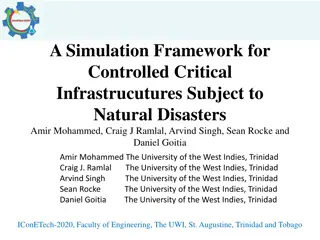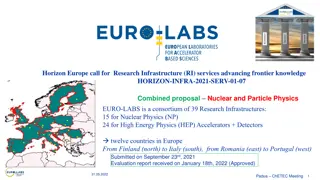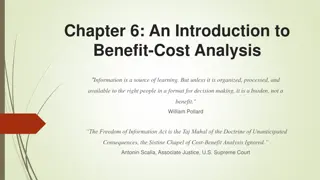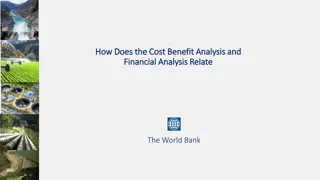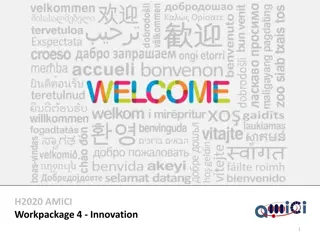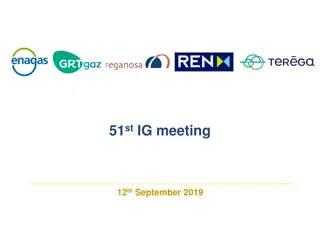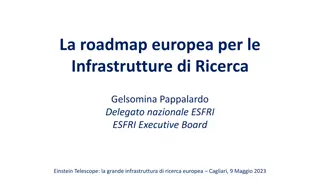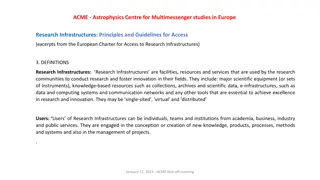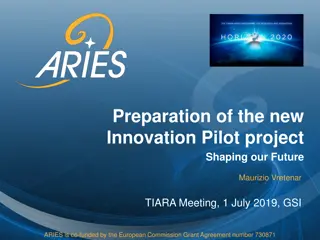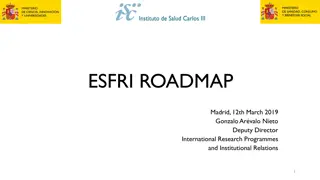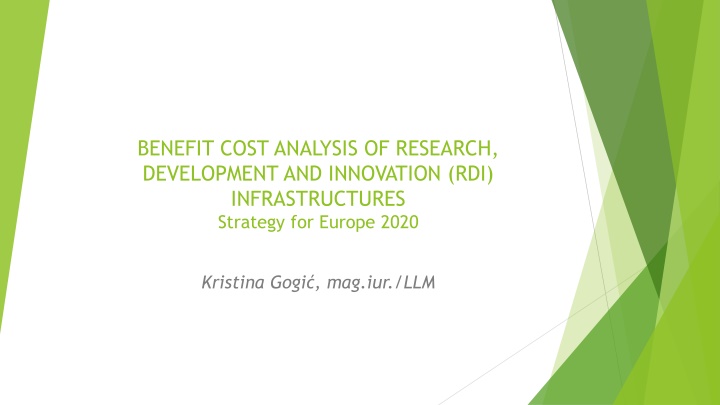
Benefit-Cost Analysis of RDI Infrastructures in Europe 2020
RDI infrastructures present unique challenges in evaluating their impact due to diverse target groups involved. The European Union emphasizes the importance of research, development, and innovation for sustainable economic growth.
Download Presentation

Please find below an Image/Link to download the presentation.
The content on the website is provided AS IS for your information and personal use only. It may not be sold, licensed, or shared on other websites without obtaining consent from the author. If you encounter any issues during the download, it is possible that the publisher has removed the file from their server.
You are allowed to download the files provided on this website for personal or commercial use, subject to the condition that they are used lawfully. All files are the property of their respective owners.
The content on the website is provided AS IS for your information and personal use only. It may not be sold, licensed, or shared on other websites without obtaining consent from the author.
E N D
Presentation Transcript
BENEFIT COST ANALYSIS OF RESEARCH, DEVELOPMENT AND INNOVATION (RDI) INFRASTRUCTURES Strategy for Europe 2020 Kristina Gogi , mag.iur./LLM
RDI INFRASTRUCTURES Benefit Cos Analysis (BCA) of the research, development and innovation (RDI) infrastructures is a new field; 1) The research, development and innovation (RDI) infrastructure is the generic name for investment projects that are designed and operated according to very different specifications and cannot be analyzed with the same degree of standardisation of methods as, - for example, in railways or water; 2)
RDI INFRASTRUCTURES While the target groups of other infrastructures are relatively well identified: - e.g. passangers for high-speed rail or residents in a urban area for solid waste management, the multifaced nature of RDI is such that many types of direct and indirect taget groups are involved: - from business to the general public; Each of them has standing in the BCA, and this makes the evaluation of infrastructures a particulary complex task.
RDI INFRASTRUCTURES It is expected that over the planning period (2014.-2020.) a portofolio of BCA of RDI infrastructures will be gradually built within the European Union (EU) Member States (MS), following the high priority given to research and innovation for the EU growth strategy;1) Many research and innovation R&I projects face difficulties in securing finance despite being fundamentally good projects;
INNOVFIN ADVISORY InnovFin Advisory (IFA) was set up as a joint European Investment Bank European Commission initiative under Horizon 2020 IFA assists eligible public and private counterparts to improve the bankability and investment readiness of large, complex, innovative projects that need substantial long term investments
RDI IN THE EU POLICY AGENDA RDI are at the core of the policy agenda as key drivers of sustainable long-term economic development Strategy for Europe 2020 puts RDI at the top of the EU agenda for smart, sustainable and inclusive growth The European Commission lauched the innovation Union flagship initiative, aimed to ensure that innovation ideas can be turned into products and services that create economic growth and jobs.
Standard BCA of RDI Infrastructures Definition of RDI infrastructures Research and development infrastructures are science related physical realisations (laboratories, facilities, etc.) developed with the main purpose of acquiring new knowledge in a given scientific and technological field; 1) Innovation infrastructures are infrastructures aimed at combining knowledge and technology for the development of new or improved products, services and business processes that could be sold on the marketplace 2), 3)
Standard BCA of RDI Infrastructures Description/Presentation of the context Socio-economic trend; 1) Policy and legislative framework; 2) Geographical conditions and availability of resources; 3) Current level of research and innovation; 4) Conditions of the existing research facilities and infrastructural needs 5)
Standard BCA of RDI Infrastructures Definition of objectives RDI projects can be associated with a multitude of long- term objectives; i.e.: 1) - strenghten the cooperation between research, innovation, education and business to create more jobs and increase economic competitiveness; - enhance the attractiveness of a cluster or science park for investors and companies; 2) - promote the mobility of researchs and associated exchange of ideas
Standard BCA of RDI Infrastructures Project identification The proposed project must be described in details as a self-sufficient unit of analysis; - when RDI investments consist of single-site facilities, the project identification becomes relatively straightforward 1) - geographically distributed RDI facilities, consisting of a network of infrastructures and equipment located in different places (or countries) can also be identified as a self-sufficient project if there is a strong functional relationship among all of its parts 2)
Project identification RDI investments aimed at fostering cooperation between a number of research facilities and knowledge transfer/innovation facilities; - located in the same area (city or region); - are not incorporated within one single- site infrastructure; - could still be considered as a single project and a self-sufficient unit of analysis for the purpose of the BCA as long as they create strong synergies, critical mass and achieve cost savings for each facility involved
Standard BCA of RDI Infrastructures Demand analysis The demand of RDI infrastructures is actually driven by the social and economic needs expressed by a multiplicity of target groups; i.e. stakeholders who/which will ultimately benefit from the intervention; 1) The macro categories of target groups, which drive the demand for the RDI project at regional and/or national level, can be identified: - business; 2) - researchers, young professional and students; 3) - target population and the general public 4) 5)
Demand analysis Examples of factors driving the demand Possible methods for data gathering and estimation Examples of output from the demand analysis Target group - Average growth of the industrial base in the RDI project field in the last years - Knowledge intensity of businesses in sectors related to the RDI project - Statistical analysis of historical data - Benchmarks with similar RDI projects - Relevant literature and existing studies - Interviews, surveys, consultations - Annual number of spin- offs/start-ups expected to be generated - supported by the project - Expected number of business using the infrastructure to develop new/improved products and processes Business - Number of scientists operating in the RDI project field and in the geographical area targeted by the infrastructure - Statistical analysis of historical data - Relevant literature and existing studies - Demographic projections - Annual number of researchers who will directly use the RDI infrastructure - Revenues from student fees Researchers, young professionals and students - Existance of knowledge transfer agreements to the RDI infrastructures - Provisions of outreach activities by the project - Statistical analysis of historical data - Benchmarks with similar RDI projects - Relevant literature and - Annual number of people potentially targeted by the project - Annual number of patients treated by Target population and general public
Standard BCA of RDI Infrastructures Option analysis The option analysis aims at identifying the most promising project option that can achieve the expected objective given a certain demand The baseline for the option analysis is the description of a scenario without-the-project for which alternative options can be conjectured RDI project options: strategic, technological, location and architectual; could differ one from another from multiple perspective 1)
Standard BCA of RDI Infrastructures Financial analysis Investment, operation and maintenance costs O&M costs Investment costs - Planing and design costs - Land acquisition - Construction costs, possibly disaggregated by civil works and installations, materials, labour etc. - Energy, waste disposal and other utilities consumed during the construction period - Road access - RDI equipment, including information technologies (particulary for data storage or elaboration) - Intellectual property purchase costs - Testing - Start-up costs - Materials and equipment - Consulting services - Costs of scientific personnel - Cost of administrative and technical staff - Cost of obtaining and maintaining patents - Energy, waste disposal and other utilities - Promotional campaigns and other outreach expenditure to the general public - Training courses connected to the infrastructure s operation and management
Standard BCA of RDI Infrastructures Financial analysis Revenues and financing sources Examples of operating revenues Examples of financing sources - Licenece revenues gained from patents commercialisation; - Sale of consultancy services - Revenues from industrial research contracts and pre- commercial procurements contracts - Entry fees to the laboratory and for the use of research equipment charged to researchers and business - Student/master/PhD fees - Spin-off equity realisations - Research grants involving a transfer of ownership of a specific research output - Sale or rent of new buildings used for the project s objective - Revenues from the target population using the research outputs (e.g. patients receiving an innovative treatment) - National/regional public contributions - National/regional private contributions - EU contribution - Other national/regional funding schemes for RDI activities - Public grants to research, e.g. the Horizon 2020 framework - Ordinary public transfers
Standard BCA of RDI Infrastructures Economic analysis The main difficulty is the estimation of the social benefits from a range of diverse projects: - from research centres on climate change to scientific and technological parks; or - from high-energy physics research infrastructures to bio-molecular research facilities Typical benefits (who is going to be targeted?): - for business;1) for researchers, young professionals and students;2) for the target population and general public 3)
Standard BCA of RDI Infrastructures Economic analysis Valuation of benefits To business: the general rule is that any change beneficial to a business should be valued by incremental shadow profits 1) To researches and students: one of the main benefit is the opportunity to access new experimental data, to contribute to the creation of new knowledge and to publish scientific papers in scolary journals 2) - the main benefit for junior researchers and students involved in the project is a premium for their future salary, resulting from the aquisition of human capital 3)
Standard BCA of RDI Infrastructures Economic analysis Valuation of benefits To target population and the general public: - reduction of environmental risks; the most encompassing risk for the human kind is climate shange 1) - reduction of the health risks; the discovery and testing of new drugs, new advanced forms of surgery assisted by robotics, radiotherapy with non-conventional beams, genetics, etc. 2) - cultural effects for visitors; 3)
Standard BCA of Infrastructures Risk assessment; Typical risks in RDI projects Stage Risk - Evolutions in the labour market; Insufficient qualified human resources for research activity; Interest of general public different than predicted Demand analysis - Inadequate site selection; Inadequate design cost estimates; Delays in completing the project design; Lack of well-established technical engineering expertise - Delays in obtaining building permits; Unresolved property ownership rights; Procedural delays to select the supplier and sign the procurement contract; Supply bottlenecks - Project cost overruns; Delays in complementary works outside the project promoter s control; Accidents Design Administrative and procurement Construction - Unexpected complications connected with the installation of specialised equipment; Insufficient production of research results; Lack of academic staff/researchers - Inadequate estimate of financial revenues and system for protection and exploatation of intellectual property; Loss of existing clients/users due to competition from other RDI centres Operation Financial
THANK YOU ON YOUR ATTENTION! www.kristinagogic.com Questions? kristina.gogic@ombudsman.hr kristinagogic1@gmail.com





